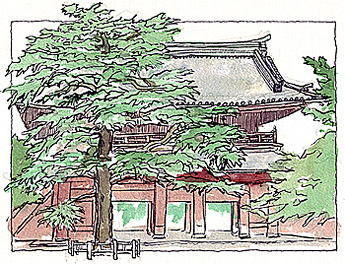|
Page 14. How to Sketch (continued)

If you are sketching in water soluble ink and coloring with watercolors, then you will want to use the watercolors first so the ink won't run. This is a fun way to sketch if you have never tried it. You can skip the preliminary underdrawing part and block in areas with colors, starting with light colors and going gradually darker and more saturated. Some people may find they can sketch anything with a fair amount of accuracy using this method.
If you are using waterproof ink or pencil, then the watercolors can come first or last.
In general, most watercolor sketchers prefer to put in the lighter colors with more water first since they can be covered later with darker colors. The sky is often a good place to start. If you are using traditional brushes, you can paint a large expanse of sky with a consistent color in a single stroke.
Letting the waterbrush work for you
However, if you are using waterbrushes, it's usually better to break up the sky with clouds, since the water to paint ratio in a waterbrush stroke is constantly changing, going from dark and saturated to light and watery. There are flat waterbrushes on the market which may allow you to get larger, consistent areas of color, but it will take some practice.
You can use this feature to your advantage in other areas of the sketch by getting some nice variation within color areas. Just start the stroke where you want the color to be darkest, and end the stroke where you want the color to be lightest. You can mix some colors on the palette and other colors right on the sketch by painting different colors next to each other and letting them touch and bleed into each other or overlap.
One idea to save time on cleaning your brush is to paint all similar colored areas at the same time. For example, paint all the green areas while you have green paint on your brush. This especially makes sense if you have carried a limited water supply with you or are using waterbrushes.
If you want to keep the coloring fresh looking, try not to overdo the painting process but limit it to a few layers. Also, don't scrub the colors into the paper, but keep a light touch. Otherwise the paper surface may start to break up and you'll get ugly specks.
By the way, it's not necessary to labor with the mixing process to get the color exactly as you see it in the subject. Your style may be to paint the world a bit brighter and more colorful than it really is, or you may have other ideas of how things ought to be colored. If your goal is to produce something interesting, then you have a lot of freedom.
Working partially from imagination
There may be times when you do the line work on location and color the sketch at home from memory or imagination. These may turn out to be your finest sketches because you are no longer constrained by the subject.
You may want to stop short of finishing your painting on the spot and wait until you get home to add the final touches. Sometimes you will not have time to even bring out your watercolors on location, and must wait until you get home to begin coloring it.

I was only able to take the sketch this far before it started to rain. So I packed up my stuff and finished it later at home. |
As long as you are standing on location before your subject, you are working to get a likeness of the subject before you, but at home you are working from imagination. You can no longer see the subject; only the sketch as everyone else will see it. This gives you freedom to make it more dramatic work of art.
I finished this sketch at home where I was forced to work from imagination, adding what I thought was needed to make it a complete sketch.
Sometimes I deliberately leave a sketch in its unfinished state and wait until I get home to add the final touches. This puts more of my own imagination into the sketch. These images of the sketch of Grant's Fir Tree at Zojoji temple in Shiba Park in Tokyo show how I was forced to finish the sketch from imagination.
Adding color later
Here are a few examples of sketches that were colored later on a different day. These sketches also appear elsewhere in my online sketchbook.
This is a boat docked on the east bank of the Arakawa River near my home. This was done with brush, pen and ink.
I added color a few weeks later, and relied on memory and imagination. I think this turned out better this way because I was able to put more of myself in the sketch, and leave out some stuff that was not interesting.
This sketch was done with fountain pen and Platinum Carbon ink. It's a liquor shop in a shopping street in my neighborhood.
I added color a few days later with a waterbrush. I found that skies are easy to paint with waterbrushes if you break the blue up with clouds, and keep it soft by wet-in-wet.
| 


